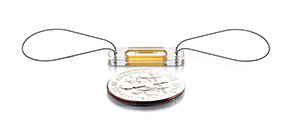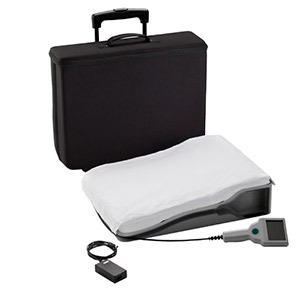What is the CardioMEMs Heart Failure System?

The CardioMEMs Heart Failure (HF) System (CardioMEMs) is a very small device that is implanted in your pulmonary artery (the blood vessel that carries blood from your heart to your lungs) to help your doctor make sure you are getting the best treatment possible for heart failure.
An implanted sensor in the CardioMEMs measures your pulmonary artery pressure and heart rate, and this information is electronically and wirelessly sent to your doctor. You may have changes that can be seen even before you start to feel symptoms, and your doctor can adjust your treatment plan and/or medications accordingly.
Who can get a CardioMEMs?
The CardioMEMs is used in select patients who have New York Heart Association (NYHA) Class III heart failure and have been hospitalized for heart failure within a year’s time. If you are interested in getting the device, you will need an evaluation by one of Cleveland Clinic’s heart failure specialists.
You cannot have a CardioMEMs if you cannot take blood thinners or antiplatelet medications for at least one month after the implant procedure.
The device is being studied to see if it can help other patients.
How is the CardioMEMs implanted?
The CardioMEMs is implanted during an outpatient procedure in the catheterization lab. You will most likely not spend the night in the hospital.
IMPORTANT: You must have someone with you to drive you home. You will also need to have someone stay with you for 24 hours after you leave the hospital.
Before the Procedure – At home
- DO NOT eat or drink anything after midnight the night before your procedure.
- Talk to your doctor about ALL medications and supplements you take. Follow all instructions about changing or stopping certain medications. DO NOT stop or change the way you take any medication unless your doctor tells you to do so.
Before the Procedure – At the hospital
- You will change into a hospital gown, and your nurse will get you ready for the procedure. This includes:
- An intravenous (IV) line in your arm to give you medications and fluids during the procedure.
- Cleaning and shaving (if needed) your groin area on both sides.
- The cardiac catheterization room is cool and dimly lit. The cool air prevents damage to the X-ray equipment used during the procedure. We will give you warm blankets to keep you comfortable.
- You will lie on a special table. If you look above, you will see a large camera and several TV monitors. You may be able to watch your cardiac catheterization on the monitors.
- The nurse will clean your skin at the top of your leg (groin) where the catheter (narrow plastic tube) will be inserted.
- Sterile drapes are used to cover the site and help prevent infection. It is important that you keep your arms and hands down at your sides, under the sterile drapes.
- Several small, flat, sticky patches (electrodes) will be placed on your chest. The electrodes are attached to an electrocardiograph monitor (ECG), which monitors your heart rate and rhythm.
During the procedure
You will be awake and conscious during the procedure.
The doctor will inject anesthetic to numb your groin area. A short, hollow tube (plastic introducer sheath) will be inserted in the femoral vein in your groin. A catheter will be inserted through the sheath and guided to the pulmonary artery where we measure the blood pressure in your heart and lungs. You may feel pressure as the sheath and catheter are inserted, but you should not feel pain. Tell the nurse or doctor if you feel any pain.
Contrast dye will be injected to take a picture of the pulmonary artery and find the artery that will be used for the CardioMEMs. The device sensor is then put in place in the artery branch. Once the sensor is in the right spot, the wires and catheter are removed. Another catheter is used to measure the blood pressure in your lungs, and a flat wand is placed under your back to help calibrate the pressures being measured by the CardioMEMs.
The sheath will be removed after the device is calibrated or while you are in the recovery area.
After the procedure
A responsible adult MUST drive you home after the procedure. You will not be discharged unless you have a driver.
You will need to stay in bed for two hours after the sheath is removed. During this time you will learn how to use the CardioMEMs.
While you are in bed, you will need to use a bedpan or urinal. It is normal to feel the need to urinate more than you normally do. Make sure you drink plenty of liquids to flush the contrast dye from your body.
How do I use the CardioMEMs at home?

The CardioMEMs is very easy to use. You will not feel it, and it will not affect your normal routine.
You will get an electronic pillow that reads information collected by your CardioMEMs sensor. You will lie on the pillow every day to send the information to your healthcare team.
Your healthcare team will review the information and use it to make sure you are taking the right types and amounts of medications.
You will not get information every day. The CardioMEMs team will let you know how often they will be in touch, and they will contact you during the week as needed. The team does not review readings after hours or on the weekends.
What are the benefits of CardioMEMs?
Your doctor will talk to you about the benefits of CardioMEMs, including:
- Using the device information to make changes to your treatment before you feel symptoms.
- Being able to use the device in your home.
- A sensor that does not need a battery.
- The device is MRI conditional for 1.5 and 3 Tesla MRIs.
What are the possible risks of CardioMEMs?
All medical procedures carry a risk of complications. Your doctor will talk to you about your individual risks. Although rare, some possible problems related to a CardioMEMs implant include:
- Irregular heart rhythm.
- Bleeding at the incision site.
- Blood clot.
- Death.
- Device embolization.
- Hematoma.
- Infection.
- Myocardial infarction.
- Stroke or transient ischemic attack.
What is the long-term outlook after a CardioMEMs implant?
The CardioMEMs system will help your healthcare team adjust treatment, as needed. This will help improve your quality of life and reduce your risk of being hospitalized for problems caused by heart failure.
Reference
Abraham, W. T., Stevenson, L., Bourge, R. C., Lindenfeld, J., Bauman, J., & Adamson, P. B. (2016). Sustained efficacy of pulmonary artery pressure to guide to adjustment of chronic heart failure therapy: Complete follow-up results from the CHAMPION randomized trial. The Lancet, 387(10017), 453-461. sciencedirect.com/science/article/pii/S0140673615007230?via%3Dihub Accessed 1/21/2019.